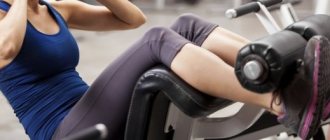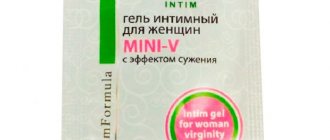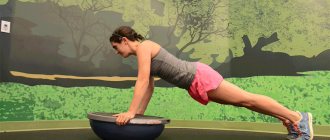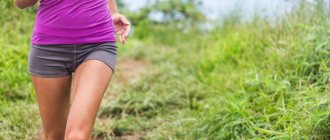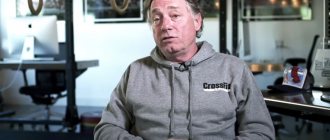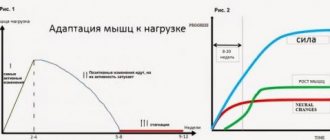How to build muscle without steroids
In bodybuilding there is a distribution:
- there is natural training (such people are called naturals) (these are those who do not use anabolic steroids)
- there is chemical training (such people are called chemists) (these are those who use steroids)
I focus on natural training because I myself have never used steroids.
This is the same story when the game is not worth the candle, because... muscles specifically aren’t worth it for me, but the possible health side effects from these steroids can be so serious that most people can’t even imagine.
Personally, I am for natural training for myself, where the goal is to have a strong, healthy and functional body. And not these huge inflatable muscles...
However! Since I am for freedom of choice, in this section you will find everything to suit your purposes.
IS IT POSSIBLE TO ELIMINATE THE GAG?
Obviously yes. Therefore, the principle of “specificity in sports”
tells us what?
Right! WHAT WE TRAIN DEVELOPES!
Everyone knows that LOCAL GROWTH is possible
.
That there are people who train only certain muscles and these are the muscles that are most developed. This is due to our unique biochemistry and physiology of the body. Muscles respond to the influence of hormones and local growth factors that are released under the influence of training
. This means that we can organize training in such a way as to achieve more significant local growth in the muscle that is lagging behind. If, of course, we want to. But we will want to. Right?
One-day specialization program (“Punching”)
The essence of this method is that the athlete came to the gym for 12 hours (of course, with a supply of food and water) and “bombed” the muscle group as follows: every hour he did 3 sets of 6-8 repetitions of the basic exercise with a barbell and every half hour - 3 sets of 10-12 repetitions of an exercise with fillets or on a block, which is of an isolating nature.
The most frequently used pairs were the following:
- for the chest - bench press or at an angle, horizontal or at an angle,
- for the widest - bent over row or T-row row on the upper block to the chest or behind the head,
- for the quadriceps - squat or leg press extension.
Arms and deltoids were usually not specialized in this way, since there was a high risk of overtraining.
For greater clarity, I will give an example of how such a specialization, say, for the chest muscles, should look chronologically. From 800 to 2000:
- 800 - bench press at an angle of 12, 10 - warm-up, 3x6-8;
- 815 - wiring, 3x10-12; 8″ — wiring, 3x10-12;
- 900 - bench press at an angle, 10 - warm-up 3x6-8;
- 915 - wiring, 3x10-12, etc.
In between doing exercises, you have a light snack, preferring complex carbohydrates.
2-3 days after completing such a specialization should be given to complete rest. The first workout after the “feat” should have been selected in such a way that the muscle group on which the “punching” was done and its synergists were not loaded during this session.
Please note that this is a very tough method, and you will be guaranteed severe pain in the target muscle for at least a week. But then this group very gratefully begins to respond to any load.
Let's say that you have already laid the foundation for the transition to specialized programs aimed at “pulling up” lagging muscle groups. Where to start now?
First of all, make sure you DO lay that foundation. This means, firstly, that you squat with a weight of at least one and a half times your own (for example, if your weight is 75 kg, then your barbell is 150 kg, if you weigh 85 kg - 170, and so on). Moreover, you must do at least 20 full repetitions (up to parallel), with virtually no rest between them.
If you have reached this stage, specialized programs will likely begin to produce results. But it may also happen that it is too early for you to switch to them. And you can understand this only in practice. Perhaps the conditions that I have outlined are not suitable for you specifically. Then you'll have to wait.
Read more: Take cottage cheese for muscle growth. Cottage cheese in bodybuilding: benefits for gaining muscle mass, losing weight, but NOT for cutting. How and when is it better to eat cottage cheese in bodybuilding
Don't think I'm against specialization. On the contrary, I'm all for it. I just want specialized complexes to really work. And for this it is fundamentally important to lay the basic foundation.
How you “specialize” depends on your goals and sense of self. You may feel the need to target one part of the body and give the rest a break from serious training. Perhaps, after several weeks of such work, you will have to take a break from working in the gym altogether. In any case, the success of your specialization depends on how carefully you read this chapter.
The main thing is not to overdo it. If you do specialized exercises too often and at an exaggerated volume, you will never get off the ground, even if you have laid the necessary foundation. Determine for yourself the optimal frequency of training, its volume and intensity.
Specialized programs are designed for the short term. Don't stretch them out for too long. Remember: the program is for the person, not the person for the program. Take from it everything you need - as long as it gives results. How long this period will last depends on the program itself, on the specific bodybuilder and his ability to recover.
Perhaps four weeks will be enough for you. It may take six weeks, eight, or even more. But as soon as you notice that you have squeezed everything out of the program and are starting to mark time, quit it. Take a break for a week or so and return to regular, basic routines. You can specialize later when the need arises.
In one of his books, the famous methodologist Piri Rader talks about a one-day specialization program. To begin with, he tried this specialization for his arms: he trained them every 90 minutes (six times a day) for a week. He did two exercises in two sets: one for biceps, the other for triceps, using less weight than his usual and never working to the limit. During this week, he gained 1.5 centimeters in the circumference of his upper arm.
Later, Rader transformed this specialization into a one-day version, again using hands as an example. He suggested doing two exercises every hour - one for biceps and one for triceps. The intensity here is higher than in the previous version, but still not to the point of “failure”.
After each workout, he advises massaging the muscles, and half an hour after the “main” arm workout, do a “light” workout (in the interval between two “heavy workouts”).
Read more: Leg bending in a sitting machine: technique of execution, which muscles work
While working on my book, I tried this method on myself, albeit in a slightly modified form. “If you don’t want to spend twelve hours in a row in the gym,” I thought, “then you need to train at home.” That's why I chose triceps as my goal - they don't require complex equipment.
The epic began at 9 am and ended at 9 pm. I did three sets of push-ups every hour. I performed enough repetitions to reach the point of failure, rested no more than a minute between sets, and with each set I reduced the number of repetitions: in the first set - 12 or more, in the second - 10, in the last - 7.
Every half hour, I additionally did three sets of push-ups with narrow arms, trying to ensure that all the load fell on the triceps. But at the same time, the intensity was much lower than on the “basic” push-ups, and the number of repetitions was less.
So in 12 hours I did 13 “core” workouts (every hour) and another 12 “light” workouts (every half hour). A week later I measured my arm circumference - it had increased by half a centimeter! It turns out that the game is worth the candle! Of course, not such an impressive growth as Piri Rader himself. But I only worked the triceps!
If you decide to try this method on yourself, choose an exercise that is familiar to you. And remember that the day of specialization should be completely free from extraneous distractions. Train, rest, drink nutritious drinks every hour or two and think that everything will work out.
How to lose weight and build muscle
Many people want, as they say, to eat fish and you understand...
In reality, you need to choose what is more priority for you now...
To grow muscle on the body, the process of anabolism (this is muscle growth) will be required, and to burn fat (to lose weight) the process of catabolism will be required (this is destruction).
These are two completely different and opposite physiological processes.
They cannot be combined into one whole (they cannot occur simultaneously).
Therefore, in this section, all articles are divided into such subcategories as: muscle growth and weight loss. There are also other sections, such as health training.
LOAD
Excessive load, in my opinion, is the rarest cause of muscle group lag. Much more often this is caused by insufficient load, when a person violates the technique by shifting part of the load to the joints and ligaments.
However, on a theoretical level, this reason also has its place. What are we talking about? Imagine doing 20-30 hard (to failure) sets for the biceps, which are generally considered to be very small muscles. What could this lead to? To overtraining of this muscle.
A person believes that he is specializing (increasing the load on the muscle), but in reality he is not helping the muscle, but only harming it, because the load is too excessive. It seems to me that everything will depend on the total amount of recovery capabilities of a particular person.
More specific…. If a person trains everything else the same as before, but has greatly increased the load on the biceps, then in total this may require such a recovery potential that the person does not have and then the biceps will not grow
. BUT if a person…..reduces the load on all other muscles, then he will thereby allocate recovery resources for the biceps and this will give him the opportunity to really progress in it. However, we are already considering the issues of “treatment” (eliminating backlogs). More on this below.
CONCLUSION:
the load on the muscle must be proportionate to its recovery capabilities. Otherwise, your muscle will not grow and the gap in the gap will only increase.
How to train your health in the gym
This section, among other things, contains a lot of information about:
- How to improve your health
- How to train your health in the gym
- How to take care of your health in general
- How to enhance your biological potential
- How to cleanse your body of poisons and toxins
- How to detoxify your body
- How to take care of yourself and your overall health
- and many many others…
Many articles with a detailed description and selection of special exercises for health training, a detailed description and preparation of training programs (schemes) to improve health, the basic principles of health training and much more...
Pumping mechanism
When you pump, you purposefully pump blood into your muscles. There are certain ions in the blood that pull water with them. Thus, liquid penetrates the cells and fills them, increasing their volume. Totally swollen cells give a 5–10% increase in muscle volume.
Due to pumping, any person receives a small visual increase in muscle mass.
Blood is pumped into the muscles through exercise. The process is accompanied by a specific sensation of muscle expansion: it is difficult for you to bend your arm, for example, because your biceps is in the way. At this moment you feel more, which is confirmed both visually and to the touch. It's like you're full of water.
What is pumping in practical terms? It is multi-repetition training in which the number of repetitions reaches 15 or more.
The pump effect can be caused by:
- Physical activity.
- Special additives.
In the first case, everything is clear - they came, swayed properly, and everything was ready. In terms of supplements, things are a little different.
The essence of the drugs is to retain fluid in the body. The range of drugs is large, ranging from arginine-containing supplements to steroids. Creatine and some fat burners retain water. Please note that the accumulation of water in the body can have negative sides!
https://youtu.be/tWK7QkBBfqg
One exercise method (“Punching-2”)
There are many different exercises in bodybuilding.
Personally, I highlight:
- weak in efficiency
- average in efficiency
- the most highly effective
Naturals (people who do not use anabolic steroids) should not waste time on any nonsense because there will be no effect (sense) from it at all or it will be negligible.
Read more: Is it possible to drink protein without training and what will happen from taking the supplement without exercise?
And our goal is to quickly achieve the desired results (lose weight/grow muscles).
This method is similar to the previous one with the only difference that it does not take the whole day. You come to the gym as usual, warm up and then perform just one basic exercise with a barbell for the lagging muscle group for 6-8 repetitions. Rest between approaches - as in a regular workout, and the number of approaches - until, as you exhaust your strength, you only have an empty bar in your hands. This type of training may take several hours, but the effect is amazing. Just remember to completely refrain from exercise for the next 2-3 days...
- carnitine chloride;
- potassium orotate;
- injections of cobamamide and B12;
- folic acid;
- vitamin complex;
- methionine and glutamic acid.
When ratibol (ecdisten) appeared on the market, of course, they began to include it in the complex.
If an athlete planned a “punching” test, then 5 days before it he began to take phosphaden injections of 1-2 ampoules per day and continued this for another 5 days after it. In the days preceding and following the “punching”, it was considered useful to make a dropper from 1-2 cans of hydrolyzed amino acids (hydrolysine, casein hydrolysate, alvesin, etc.).
The task of pharmacological support during the implementation of the general complex was to normalize the functions of the body, somewhat “driven” by specialization. For this we took:
- riboxin;
- vitamin E;
- vitamin C;
- injections of B1, B6, B12.
An important note: about 3-4 weeks before specialization, all pharmacological support was stopped so that the body was “cleansed” and the complex of drugs used for specialization “hooked” it better.
What is the minimum amount of work to do?
It has been scientifically proven that 1/3 of the previous volume of work per muscle group is enough to maintain size and strength. What will this look like in practice? Let’s say that an athlete performed 12 working approaches to the pectoral muscles in three exercises per week. Therefore, for support, it is enough to leave one exercise in 4 sets per week and not try to progress in it. It is better to choose a basic exercise.
Secondly, the load on the specialized muscle group should increase. It is usually recommended to train this muscle group two to three times a week. It's better to choose 2 times. The load should be distributed evenly so that there are equal periods of time between workouts. The workout itself should be devoted exclusively to a specialized muscle group; at most, you can add abdominal crunches. Supported muscle groups are worked on separate days.
Thirdly, specialization will be performed on only one large muscle group (legs, back, pectorals) or two small ones (calf + arms or deltoids + arms). The maximum you can afford is one large and one small muscle group, for example, pectoral and triceps. That's it, no more! If the specialization goes entirely to the legs, then it’s worth limiting yourself to them; there’s no point in taking an additional small group. If you only need to tighten the back of your thighs, then you can take a small group such as biceps or triceps.
